CIR-Driven Geomagnetic Storm and High-Intensity Long-Duration Continuous AE Activity (HILDCAA) Event: Effects on Brazilian Equatorial and Low-Latitude Ionosphere—Observations and Modeling
Abstract
1. Introduction
2. Materials and Methods
2.1. Solar and Interplanetary Parameters and Geomagnetic Indices
2.2. Digisonde Measurements
2.3. Global Positioning Systems GPS-TEC
2.4. Global Ultraviolet Imager (GUVI) Database
2.5. Fejer and Scherlies Model Description
3. Results and Discussions
3.1. CIR/HSS-Driven Geomagnetic Storm on 12–23 October 2003
3.2. F-Layer Heights and Plasma Frequencies
3.3. Plasma Drift: Fejer–Scherliess Model
3.4. TEC Variations
3.5. Changes in Thermospheric Composition
3.6. EIA Development
3.7. Ionospheric Irregularities
3.8. CIR/HSS-Driven Storm and HILDCAA vs. Hallowen Storm in October 2003
4. Final Remarks
- The CIR/HSS-driven storm induced significant ionospheric disturbances, including an intensified vertical drift (exceeding 10 m/s), a poleward expansion of the EIA (up to −20° dip latitude), and prolonged TEC enhancements (up to 65 TECU) that persisted throughout the ∼9-day recovery phase. These effects coincided with the HILDCAA event (15–22 October), highlighting the sustained impact of CIR-driven storms on ionospheric electrodynamics.
- The storm’s main phase produced a pronounced F-layer uplift due to PPEF, with increasing by approximately 120 km at São Luís. This uplift extended the EIA crest poleward beyond its climatological range. Although the moderate CIR-driven storm did not trigger a Super Fountain Effect, it resulted in a sustained positive ionospheric storm, with TEC values remaining 30–50% higher than quiet-time levels across low-latitude and SAMA regions.
- Thermospheric composition changes, as indicated by variations in the [O]/[N2] ratio, played an important role in ionospheric density fluctuations. Enhancements in [O]/[N2] (exceeding 50%) coincided with TEC increases, while reductions in this ratio were associated with plasma depletion—particularly near the SAMA—underscoring the combined roles of electrodynamic forcing and neutral dynamics in storm-time ionospheric behavior.
- Periodic fluctuations in F-layer heights were observed throughout the recovery phase, particularly from 16 to 22 October, with deviations in , , and reaching ±100 km, ±100 km, and ±4 MHz, respectively. Negative excursions in and were mainly seen over the equator, while only positive uplifts were recorded at the southern EIA crest. This spatial pattern suggests the influence of DDEF and related neutral wind circulations, which drive equatorward winds and induce downward plasma drifts near the magnetic equator while sustaining uplift at low latitudes due to meridional wind surges and recombination suppression [52].
- TEC analysis revealed an extended fountain effect, with the EIA reaching up to −20° dip latitude and persisting for several days. Unlike transient positive storm phases typically observed in CME-driven storms, CIR/HSS-driven storms support sustained plasma redistribution. TEC variability during post-sunset hours suggests that storm-induced PPEF may have interacted with the PRE, further enhancing upward drifts and maintaining the EIA structure.
- Plasma irregularities detected via ROTI expanded poleward, particularly between 10° and 15° dip latitude, with values ranging between 0.5 and 1 TECU/min. This indicates an increased likelihood of ionospheric scintillations and degraded GNSS performance within these regions.
Author Contributions
Funding
Institutional Review Board Statement
Informed Consent Statement
Data Availability Statement
Conflicts of Interest
References
- Gonzalez, W.D.; Joselyn, J.A.; Kamide, Y.; Kroehl, H.W.; Rostoker, G.; Tsurutani, B.; Vasyliunas, V.M. What is a geomagnetic storm? J. Geophys. Res. Space Phys. 1994, 99, 5771–5792. [Google Scholar] [CrossRef]
- Tsurutani, B.; Gonzalez, W.D.; Gonzalez, A.L.; Tang, F.; Arballo, J.K.; Okada, M. Interplanetary origin of geomagnetic activity in the declining phase of the solar cycle. J. Geophys. Res. Space Phys. 1995, 100, 21717–21733. [Google Scholar] [CrossRef]
- Gonzalez, W.D.; Tsurutani, B.; Clúa de Gonzalez, A.L. Interplanetary origin of geomagnetic storms. Space Sci. Rev. 1999, 88, 529–562. [Google Scholar] [CrossRef]
- Gonzalez, W.D.; Echer, E.; Clúa-Gonzalez, A.L.; Tsurutani, B. Interplanetary origin of intense geomagnetic storms (Dst <-100 nT) during solar cycle 23. Geophys. Res. Lett. 2007, 34, L06101. [Google Scholar] [CrossRef]
- Tsurutani, B.; Lakhina, G.S.; Pickett, J.S.; Guarnieri, F.L.; Lin, N.; Goldstein, B.E. Nonlinear Alfvén waves, discontinuities, proton perpendicular acceleration, and magnetic holes/decreases in interplanetary space and the magnetosphere: Intermediate shocks? Nonlinear Processes Geophys. 2005, 12, 321–336. [Google Scholar] [CrossRef]
- Ram, S.T.; Yamamoto, M.; Veenadhari, B.; Kumar, S.; Gurubaran, S. Corotating Interaction Regions (CIRs) at Sub-Harmonic Solar Rotational Periods and Their Impact on Ionosphere-Thermosphere System During the Extreme Low Solar Activity Year 2008. 2012. Available online: https://nopr.niscpr.res.in/bitstream/123456789/14049/1/IJRSP%2041%282%29%20294-305.pdf (accessed on 26 June 2024).
- Belcher, J.; Davis, L., Jr. Large-amplitude Alfvén waves in the interplanetary medium, 2. J. Geophys. Res. 1971, 76, 3534–3563. [Google Scholar] [CrossRef]
- Tsurutani, B.; Gonzalez, W.D. The cause of high-intensity long-duration continuous AE activity (HILDCAAs): Interplanetary Alfvén wave trains. Planet. Space Sci. 1987, 35, 405–412. [Google Scholar] [CrossRef]
- Blanc, M.; Richmond, A. The ionospheric disturbance dynamo. J. Geophys. Res. Space Phys. 1980, 85, 1669–1686. [Google Scholar] [CrossRef]
- Abdu, M.A.; Sobral, J.H.A.; Paula, E.R.; Batista, I.S. Magnetospheric disturbance effects on the Equatorial Ionization Anomaly (EIA): An overview. J. Atmos. Sol. Terr. Phys. 1991, 53, 757–771. [Google Scholar] [CrossRef]
- Abdu, M.A. Major phenomena of the equatorial ionosphere-thermosphere system under disturbed conditions. J. Atmos. Sol. Terr. Phys. 1997, 59, 1505–1519. [Google Scholar] [CrossRef]
- Batista, I.S.; Abdu, M.A.; Souza, J.; Bertoni, F.; Matsuoka, M.; Camargo, P.; Bailey, G. Unusual early morning development of the equatorial anomaly in the Brazilian sector during the Halloween magnetic storm. J. Geophys. Res. Space Phys. 2006, 111, A05307. [Google Scholar] [CrossRef]
- Sahai, Y.; Becker-Guedes, F.; Fagundes, P.R.; de Abreu, A.J.; de Jesus, R.; Pillat, V.G.; Abalde, J.R.; Martinis, C.R.; Brunini, C.; Gende, M.; et al. Observations of the F-region ionospheric irregularities in the South American sector during the October 2003 “Halloween Storms”. Ann. Geophys. 2009, 27, 4463–4477. [Google Scholar] [CrossRef]
- Rezende, L.F.C.d.; Paula, E.R.d.; Batista, I.S.; Kantor, I.J.; Muella, M.T.d.A.H. Study of ionospheric irregularities during intense magnetic storms. Rev. Bras. Geof. 2007, 25, 151–158. [Google Scholar] [CrossRef]
- Fejer, B.G.; Larsen, M.; Farley, D. Equatorial disturbance dynamo electric fields. Geophys. Res. Lett. 1983, 10, 537–540. [Google Scholar] [CrossRef]
- Fejer, B.G.; Scherliess, L. Empirical models of storm time equatorial zonal electric fields. J. Geophys. Res. Space Phys. 1997, 102, 24047–24056. [Google Scholar] [CrossRef]
- Richmond, A.D.; Peymirat, C.; Roble, R.G. Long-lasting disturbances in the equatorial ionospheric electric field simulated with a coupled magnetosphere-ionosphere-thermosphere model. J. Geophys. Res. Space Phys. 2003, 108, 1118. [Google Scholar] [CrossRef]
- Abdu, M.A.; Bittencourt, J.A.; Batista, I.S. Magnetic declination control of the equatorial F region dynamo electric field development and spread F. J. Geophys. Res. Space Phys. 1981, 86, 11443–11446. [Google Scholar] [CrossRef]
- Abdu, M.A.; MacDougall, J.W.; Batista, I.S.; Sobral, J.H.A.; Jayachandran, P.T. Equatorial evening prereversal electric field enhancement and sporadic E layer disruption: A manifestation of E and F region coupling. J. Geophys. Res. Space Phys. 2003, 108, 1254. [Google Scholar] [CrossRef]
- Balan, N.; Shiokawa, K.; Otsuka, Y.; Watanabe, S.; Bailey, G.J. Super plasma fountain and equatorial ionization anomaly during penetration electric field. J. Geophys. Res. Space Phys. 2009, 114, A03310. [Google Scholar] [CrossRef]
- Fejer, B.G.; Scherliess, L. On the variability of equatorial F-region vertical plasma drifts. J. Atmos. Sol. Terr. Phys. 2001, 63, 893–897. [Google Scholar] [CrossRef]
- Huang, C.S.; Foster, J.; Goncharenko, L.; Erickson, P.; Rideout, W.; Coster, A. A strong positive phase of ionospheric storms observed by the Millstone Hill incoherent scatter radar and global GPS network. J. Geophys. Res. Space Phys. 2005, 110, A010865. [Google Scholar] [CrossRef]
- Gonzalez, W.D.; Tsurutani, B. Criteria of interplanetary parameters causing intense magnetic storms (Dst < -100 nT). Planet. Space Sci. 1987, 35, 1101–1109. [Google Scholar] [CrossRef]
- Tsurutani, B.; Gonzalez, W.D.; Kamide, Y.; Ho, C.M.; Lakhina, G.S.; Arballo, J.K.; Thorne, R.M.; Pickett, J.S.; Howard, R.A. The interplanetary causes of magnetic storms, HILDCAAs and viscous interaction. Phys. Chem. Earth Part C Solar Terr. Planet. Sci. 1999, 24, 93–99. [Google Scholar] [CrossRef]
- Silva, R.P.; Denardini, C.M.; Resende, L.C.A.; Moro, J.; Sousasantos, J.; de Sousa do Carmo, C.; Su Chen, S.; França Barbosa Neto, P.; da Silva Picanço, G.A.; Campelo, J.F.B.; et al. Latitudinal responses of the ionosphere over South America during HILDCAA intervals: Case studies. Adv. Space Res. 2023, 71, 5185–5195. [Google Scholar] [CrossRef]
- Mannucci, A.J.; Tsurutani, B.T.; Iijima, B.A.; Komjathy, A.; Saito, A.; Gonzalez, W.D.; Guarnieri, F.L.; Kozyra, J.U.; Skoug, R. Dayside global ionospheric response to the major interplanetary events of 29–30 October 2003 “Halloween Storms”. Geophys. Res. Lett. 2005, 32, L12S02. [Google Scholar] [CrossRef]
- Sahai, Y.; Fagundes, P.R.; Becker-Guedes, F.; Bolzan, M.J.A.; Abalde, J.R.; Pillat, V.G.; de Jesus, R.; Lima, W.L.C.; Crowley, G.; Shiokawa, K.; et al. Effects of the major geomagnetic storms of October 2003 on the equatorial and low-latitude F region in two longitudinal sectors. J. Geophys. Res. Space Phys. 2005, 110, A12S91. [Google Scholar] [CrossRef]
- Negreti, P.M.; Paula, E.; Candido, C. Total electron content responses to HILDCAAs and geomagnetic storms over South America. Ann. Geophys. 2017, 35, 1309–1326. [Google Scholar] [CrossRef]
- Candido, C.M.; Batista, I.S.; Klausner, V.; de Siqueira Negreti, P.M.; Becker-Guedes, F.; de Paula, E.R.; Shi, J.; Correia, E.S. Response of the total electron content at Brazilian low latitudes to corotating interaction region and high-speed streams during solar minimum 2008. Earth Planets Space 2018, 70, 104. [Google Scholar] [CrossRef]
- Chingarandi, F.S.; Candido, C.; Becker-Guedes, F.; Jonah, O.F.; Moraes-Santos, S.P.; Klausner, V.; Taiwo, O.O. Assessing the Effects of a Minor CIR-HSS Geomagnetic Storm on the Brazilian Low-Latitude Ionosphere: Ground and Space-Based Observations. Space Weather 2023, 21, e2023SW003500. [Google Scholar] [CrossRef]
- Moraes-Santos, S.P.; Cândido, C.M.N.; Becker-Guedes, F.; Nava, B.; Klausner, V.; Borries, C.; Chingarandi, F.S.; Osanyin, T.O. Influence of Solar Wind High-Speed Streams on the Brazilian Low-Latitude Ionosphere During the Descending Phase of Solar Cycle 24. Space Weather 2024, 22, e2024SW003873. [Google Scholar] [CrossRef]
- Reinisch, B.W.; Galkin, I.A.; Khmyrov, G.M.; Kozlov, A.V.; Bibl, K.; Lisysyan, I.A.; Cheney, G.P.; Huang, X.; Kitrosser, D.F.; Paznukhov, V.V.; et al. New Digisonde for research and monitoring applications. Radio Sci. 2009, 44, RS0A24. [Google Scholar] [CrossRef]
- Conway, J.; Galkin, I.; Khmyrov, G. SAO Explorer User’s Guide. 2006. Available online: https://ulcar.uml.edu/SAO-X/UsersGuide.html (accessed on 12 September 2024).
- Seemala, G.K.; Valladares, C. Statistics of total electron content depletions observed over the South American continent for the year 2008. Radio Sci. 2011, 46, RS5019. [Google Scholar] [CrossRef]
- Ahn, B.H.; Kamide, Y.; Kroehl, H.; Gorney, D. Cross-polar cap potential difference, auroral electrojet indices, and solar wind parameters. J. Geophys. Res. Space Phys. 1992, 97, 1345–1352. [Google Scholar] [CrossRef]
- Ahn, B.H.; Akasofu, S.I.; Kamide, Y. The Joule heat production rate and the particle energy injection rate as a function of the geomagnetic indices AE and AL. J. Geophys. Res. Space Phys. 1983, 88, 6275–6287. [Google Scholar] [CrossRef]
- Tsurutani, B.T.; Gonzalez, W.D.; Gonzalez, A.L.C.; Guarnieri, F.L.; Gopalswamy, N.; Grande, M.; Kamide, Y.; Kasahara, Y.; Lu, G.; Mann, I.; et al. Corotating solar wind streams and recurrent geomagnetic activity: A review. J. Geophys. Res. Space Phys. 2006, 111, A07S01. [Google Scholar] [CrossRef]
- Abdu, M.A.; Sobral, J.H.A.; Walker, G.O.; Reddy, B.M.; Fejer, B.G. Electric field versus neutral wind control of the equatorial anomaly under quiet and disturbed condition-A global perspective from SUNDIAL 86. Ann. Geophys. 1990, 8, 419–430. [Google Scholar]
- Koga, D.; Sobral, J.H.A.; Gonzalez, W.D.; Arruda, D.C.S.; Abdu, M.A.; Castilho, V.M.; Mascarenhas, M.; Gonzalez, A.C.; Tsurutani, B.T.; Denardini, C.M.; et al. Electrodynamic coupling processes between the magnetosphere and the equatorial ionosphere during a 5-day HILDCAA event. J. Atmos. Sol. Terr. Phys. 2011, 73, 148–155. [Google Scholar] [CrossRef]
- Prestes, A.; Klausner, V.; González, A.O.; Serra, S. Statistical analysis of solar wind parameters and geomagnetic indices during HILDCAA/HILDCAA* occurrences between 1998 and 2007. Adv. Space Res. 2017, 60, 1850–1865. [Google Scholar] [CrossRef]
- Abdu, M.A.; Maruyama, T.; Batista, I.S.; Saito, S.; Nakamura, M. Ionospheric responses to the October 2003 superstorm: Longitude/local time effects over equatorial low and middle latitudes. J. Geophys. Res. 2007, 112, A10306. [Google Scholar] [CrossRef]
- Zhang, K.; Wang, H.; Yamazaki, Y.; Xiong, C. Effects of Subauroral Polarization Streams on the Equatorial Electrojet During the Geomagnetic Storm on 1 June 2013. J. Geophys. Res. Space Phys. 2021, 126, e2021JA029681. [Google Scholar] [CrossRef]
- Younas, W.; Khan, M.; Amory-Mazaudier, C.; Amaechi, P. Ionospheric Response to the Coronal Hole Activity of August 2020: A Global Multi-Instrumental Overview. Space Weather 2022, 20, e2022SW003176. [Google Scholar] [CrossRef]
- Tahir, A.; Wu, F.; Shah, M.; Amory-Mazaudier, C.; Jamjareegulgarn, P.; Verhulst, T.G.W.; Ameen, M.A. Multi-Instrument Observation of the Ionospheric Irregularities and Disturbances during the 23–24 March 2023 Geomagnetic Storm. Remote Sens. 2024, 16, 1594. [Google Scholar] [CrossRef]
- Zhou, W.; Song, S.; Chen, Q.; Cheng, N.; Xie, H. Determination of nighttime VTEC average in the Klobuchar ionospheric delay model. Geod. Geodyn. 2018, 9, 175–182. [Google Scholar] [CrossRef]
- Abdu, M.A. Day-to-day and short-term variabilities in the equatorial plasma bubble/spread F irregularity seeding and development. Prog. Earth Planet. Sci. 2019, 6, 11. [Google Scholar] [CrossRef]
- Jaggi, R.K.; Wolf, R. Self-consistent calculation of the motion of a sheet of ions in the magnetosphere. J. Geophys. Res. 1973, 78, 2852–2866. [Google Scholar] [CrossRef]
- Fejer, B.G.; Farley, D.; Woodman, R.; Calderon, C. Dependence of equatorial F region vertical drifts on season and solar cycle. J. Geophys. Res. Space Phys. 1979, 84, 5792–5796. [Google Scholar] [CrossRef]
- Kelley, M.C. The Earth’s Ionosphere: Plasma Physics and Electrodynamics; Academic Press: New York, NY, USA, 1989. [Google Scholar] [CrossRef]
- Abdu, M.A.; Batista, I.S.; Walker, G.O.; Sobral, J.H.A.; Trivedi, N.B.; De Paula, E.R. Equatorial ionospheric electric fields during magnetospheric disturbances: Local time/longitude dependences from recent EITS campaigns. J. Atmos. Terr. Phys. 1995, 57, 1065–1083. [Google Scholar] [CrossRef]
- Abdu, M.A.; Batista, I.S.; Bertoni, F.; Reinisch, B.W.; Kherani, E.A.; Sobral, J.H.A. Equatorial ionosphere responses to two magnetic storms of moderate intensity from conjugate point observations in Brazil. J. Geophys. Res. Space Phys. 2012, 117, A05321. [Google Scholar] [CrossRef]
- Balan, N.; Liu, L.; Le, H. A brief review of equatorial ionization anomaly and ionospheric irregularities. Earth Planet. Phys. 2018, 2, 257–275. [Google Scholar] [CrossRef]
- Tsuji, Y.; Shinbori, A.; Kikuchi, T.; Nagatsuma, T. Magnetic latitude and local time distributions of ionospheric currents during a geomagnetic storm. J. Geophys. Res. 2012, 117, A07318. [Google Scholar] [CrossRef]
- Kil, H.; Kwak, Y.S.; Paxton, L.; Meier, R.; Zhang, Y. O and N2 disturbances in the F region during the 20 November 2003 storm seen from TIMED/GUVI. J. Geophys. Res. Space Phys. 2011, 116, A02314. [Google Scholar] [CrossRef]
- Tsurutani, B.; Zhou, X.Y.; Arballo, J.; Gonzalez, W.; Lakhina, G.; Vasyliunas, V.; Pickett, J.; Araki, T.; Yang, H.; Rostoker, G.; et al. Auroral zone dayside precipitation during magnetic storm initial phases. J. Atmos. Sol. Terr. Phys. 2001, 63, 513–522. [Google Scholar] [CrossRef]
- Fejer, B.G.; De Paula, E.R.; Gonzalez, S.A.; Woodman, R.F. Average vertical and zonal F region plasma drifts over Jicamarca. J. Geophys. Res. Space Phys. 1991, 96, 13901–13906. [Google Scholar] [CrossRef]
- Buonsanto, M.J.; Witasse, O.G. An updated climatology of thermospheric neutral winds and F region ion drifts above Millstone Hill. J. Geophys. Res. Space Phys. 1999, 104, 24675–24687. [Google Scholar] [CrossRef]
- Rishbeth, H. Polarization fields produced by winds in the equatorial F-region. Planet. Space Sci. 1971, 19, 357–369. [Google Scholar] [CrossRef]
- Heelis, R.A.; Kendall, P.C.; Moffett, R.J.; Windle, D.W.; Rishbeth, H. Electrical coupling of the E-and F-regions and its effect on F-region drifts and winds. Planet. Space Sci. 1974, 22, 743–756. [Google Scholar] [CrossRef]
- Bhattacharyya, A. Equatorial plasma bubbles: A review. Atmosphere 2022, 13, 1637. [Google Scholar] [CrossRef]
- Buresova, D.; Lastovicka, J.; Hejda, P.; Bochnicek, J. Ionospheric disturbances under low solar activity conditions. Adv. Space Res. 2014, 54, 185–196. [Google Scholar] [CrossRef]
- Moro, J.; Xu, J.; Denardini, C.M.; Resende, L.C.A.; Neto, P.F.B.; Da Silva, L.A.; Silva, R.P.; Chen, S.S.; Picanço, G.A.S.; Carmo, C.S.; et al. First look at a geomagnetic storm with Santa Maria Digisonde data: F region responses and comparisons over the American sector. J. Geophys. Res. Space Phys. 2021, 126, e2020JA028663. [Google Scholar] [CrossRef]
- Fuller-Rowell, T.J.; Richmond, A.D.; Maruyama, N. Global modeling of storm-time thermospheric dynamics and electrodynamics. Geophys. Monogr. Ser. 2008, 181, 187–200. [Google Scholar] [CrossRef]
- Gan, Q.; Eastes, R.W.; Wu, Y.; Qian, L.; Cai, X.; Wang, W.; England, S.; McClintock, W.E. Thermospheric Responses to the 3 and 4 November 2021 Geomagnetic Storm During the Main and Recovery Phases as Observed by NASA’s GOLD and ICON Missions. Geophys. Res. Lett. 2023, 51, e2023GL106529. [Google Scholar] [CrossRef]
- Abdu, M.A.; Jayachandran, P.T.; MacDougall, J.; Cecile, J.F.; Sobral, J.H.A. Equatorial F region zonal plasma irregularity drifts under magnetospheric disturbances. Geophys. Res. Lett. 1998, 25, 4137–4140. [Google Scholar] [CrossRef]
- Burns, A.G.; Killeen, T.L.; Carignan, G.R.; Roble, R.G. Large enhancements in the O/N2 ratio in the evening sector of the winter hemisphere during geomagnetic storms. J. Geophys. Res. Space Phys. 1995, 100, 14661–14671. [Google Scholar] [CrossRef]
- Mayer, H.G.; Harris, I.; Spencer, N.W. Some properties of upper atmosphere dynamics. Rev. Geophys. 1978, 16, 539–565. [Google Scholar] [CrossRef]
- Meier, R.R.; Cox, R.; Strickland, D.J.; Craven, J.D.; Frank, L.A. Interpretation of Dynamics Explorer far UV images of the quiet time thermosphere. J. Geophys. Res. Space Phys. 1995, 100, 5777–5794. [Google Scholar] [CrossRef]
- Dunn, C.; Meng, X.; Verkhoglyadova, O.P. Temporal Variability of Equatorial Ionization Anomaly Crest Locations Extracted From Global Ionospheric Maps. Space Weather 2024, 22, e2023SW003737. [Google Scholar] [CrossRef]
- Tsurutani, B.; Mannucci, A.; Iijima, B.; Abdu, M.A.; Sobral, J.H.A.; Gonzalez, W.; Guarnieri, F.; Tsuda, T.; Saito, A.; Yumoto, K.; et al. Global dayside ionospheric uplift and enhancement associated with interplanetary electric fields. J. Geophys. Res. Space Phys. 2004, 109, A08302. [Google Scholar] [CrossRef]
- Abdu, M.A.; de Paula, E.R.; Batista, I.S.; Reinisch, B.W.; Matsuoka, M.T.; Camargo, P.O.; Veliz, O.; Denardini, C.M.; Sobral, J.H.A.; Kherani, E.A.; et al. Abnormal evening vertical plasma drift and effects on ESF and EIA over Brazil-South Atlantic sector during the 30 October 2003 superstorm. J. Geophys. Res. Space Phys. 2008, 113, A07313. [Google Scholar] [CrossRef]
- Dashora, N.; Pandey, R. Variations in the total electron content near the crest of the equatorial ionization anomaly during the November 2004 geomagnetic storm. Earth Planets Space 2007, 59, 127–131. [Google Scholar] [CrossRef]
- Chu, F.; Lee, C.C.; Chen, W.S.; Liu, J. A study of long-term climatology of ionospheric irregularities by using GPS phase fluctuations at the Brazilian longitudes. Adv. Space Res. 2008, 41, 645–649. [Google Scholar] [CrossRef]
- Nguyen, C.T.; Oluwadare, S.; Le, N.T.; Alizadeh, M.; Wickert, J.; Schuh, H. Spatial and Temporal Distributions of Ionospheric Irregularities Derived from Regional and Global ROTI Maps. Remote Sens. 2021, 14, 10. [Google Scholar] [CrossRef]
- Chu, F.D.; Liu, J.Y.; Takahashi, H.; Sobral, J.H.A.; Taylor, M.J.; Medeiros, A.F. The climatology of ionospheric plasma bubbles and irregularities over Brazil. Ann. Geophys. 2005, 23, 379–384. [Google Scholar] [CrossRef][Green Version]
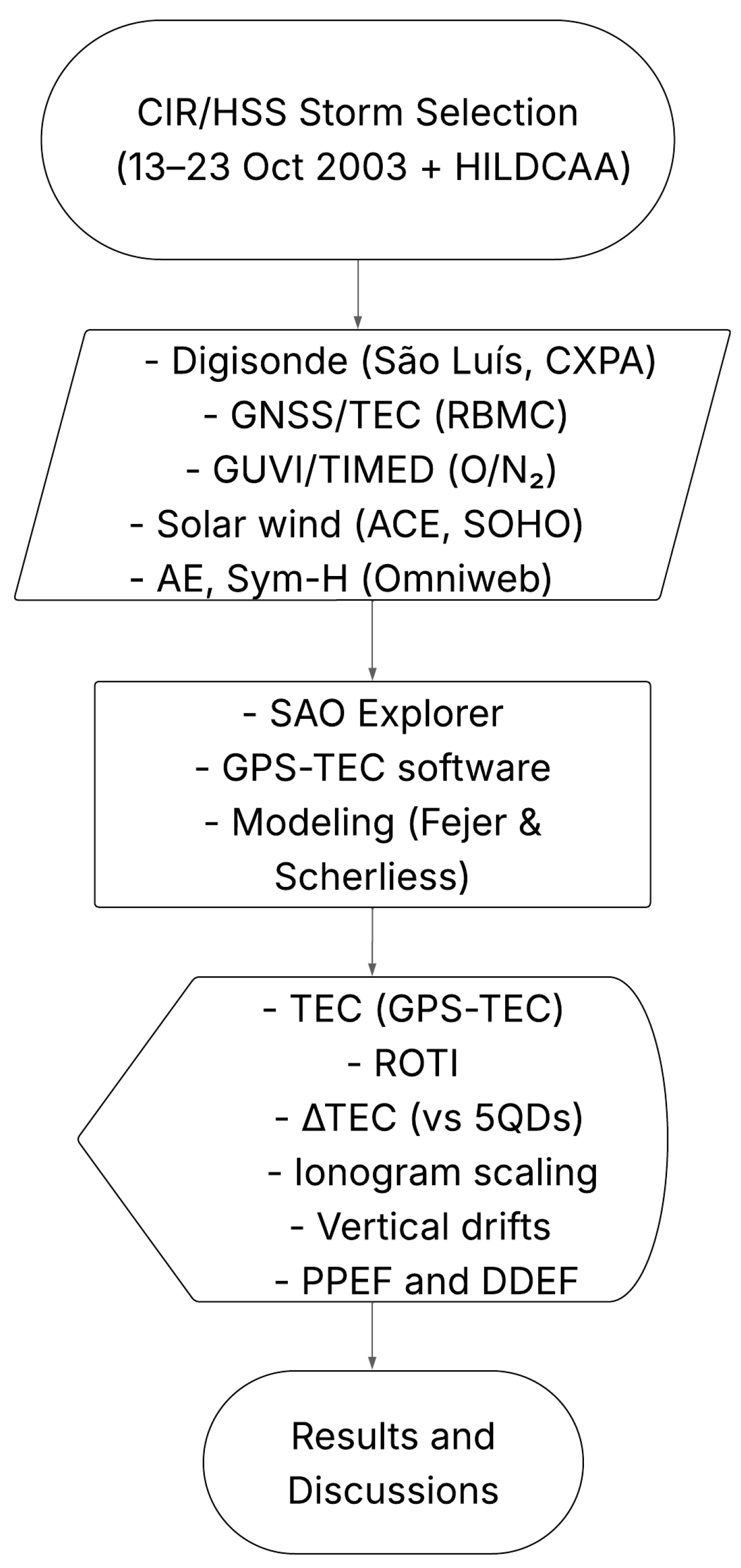
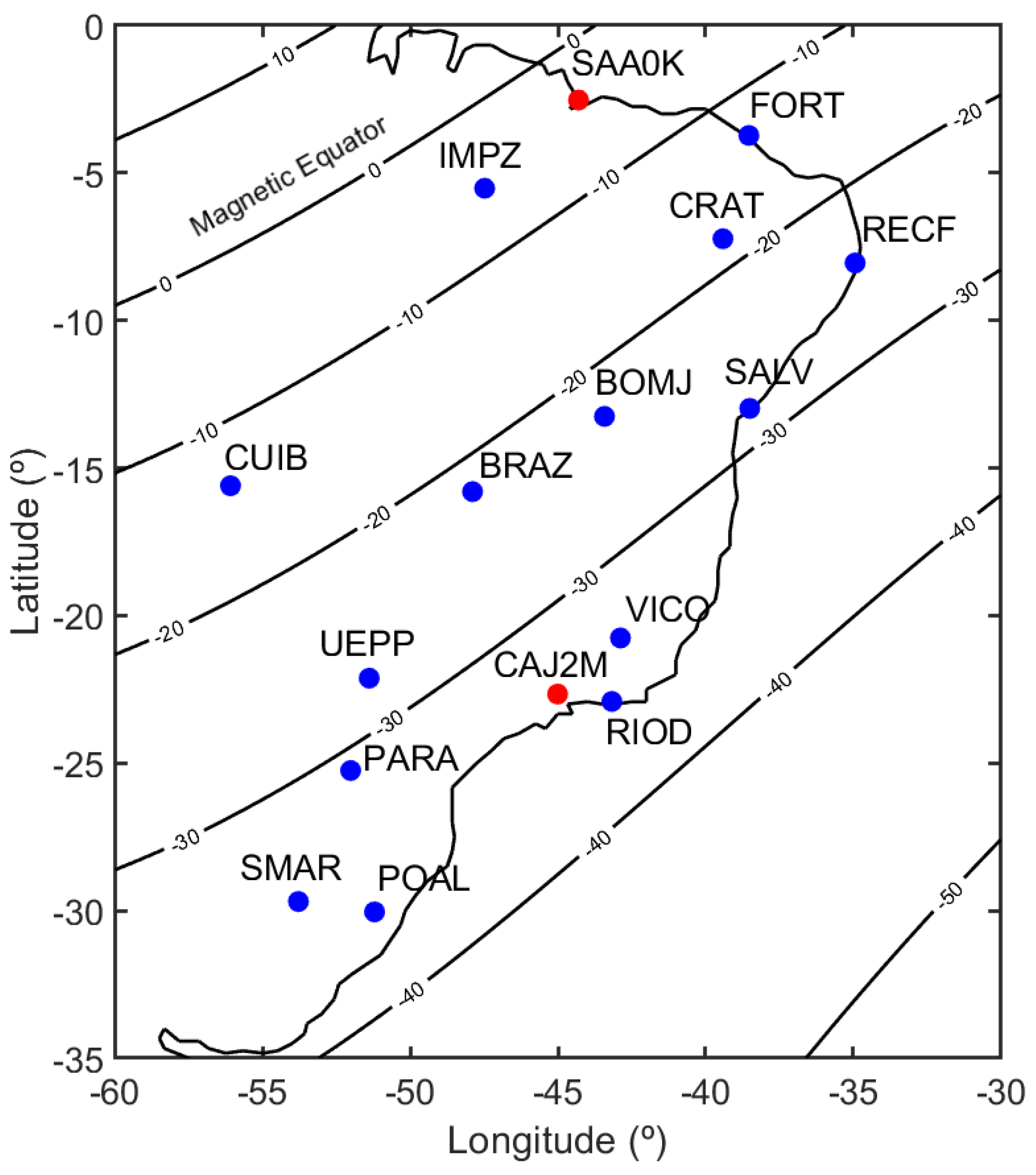
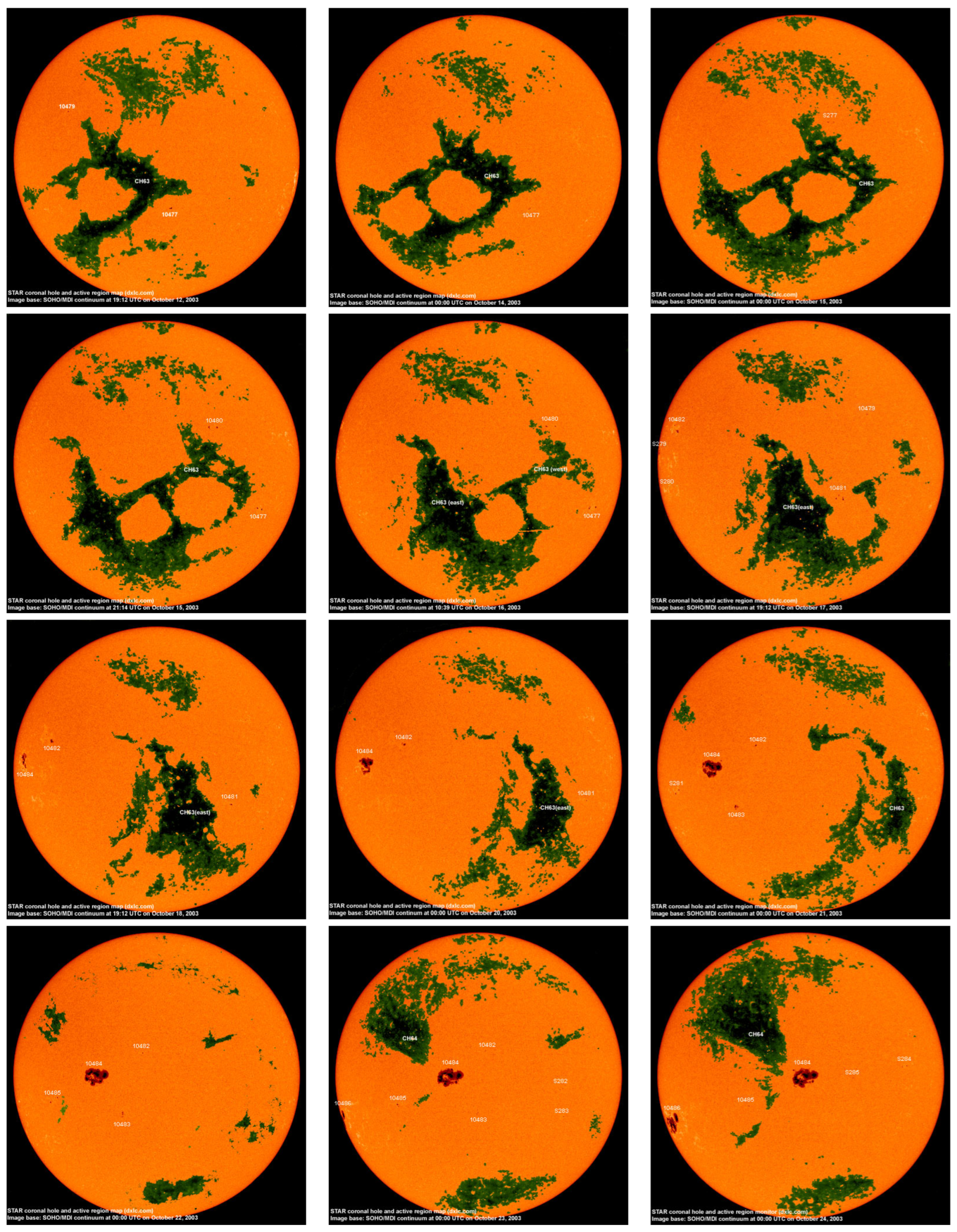
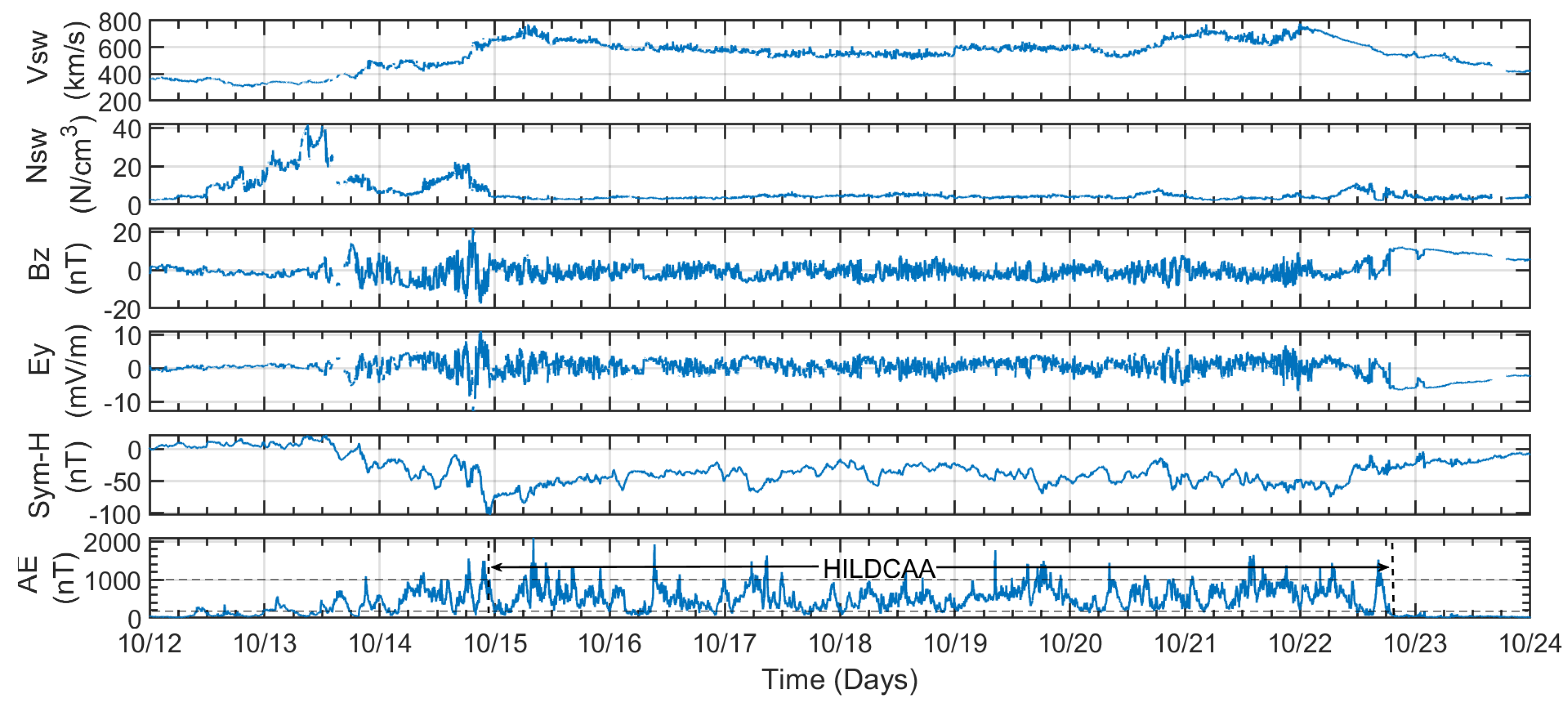

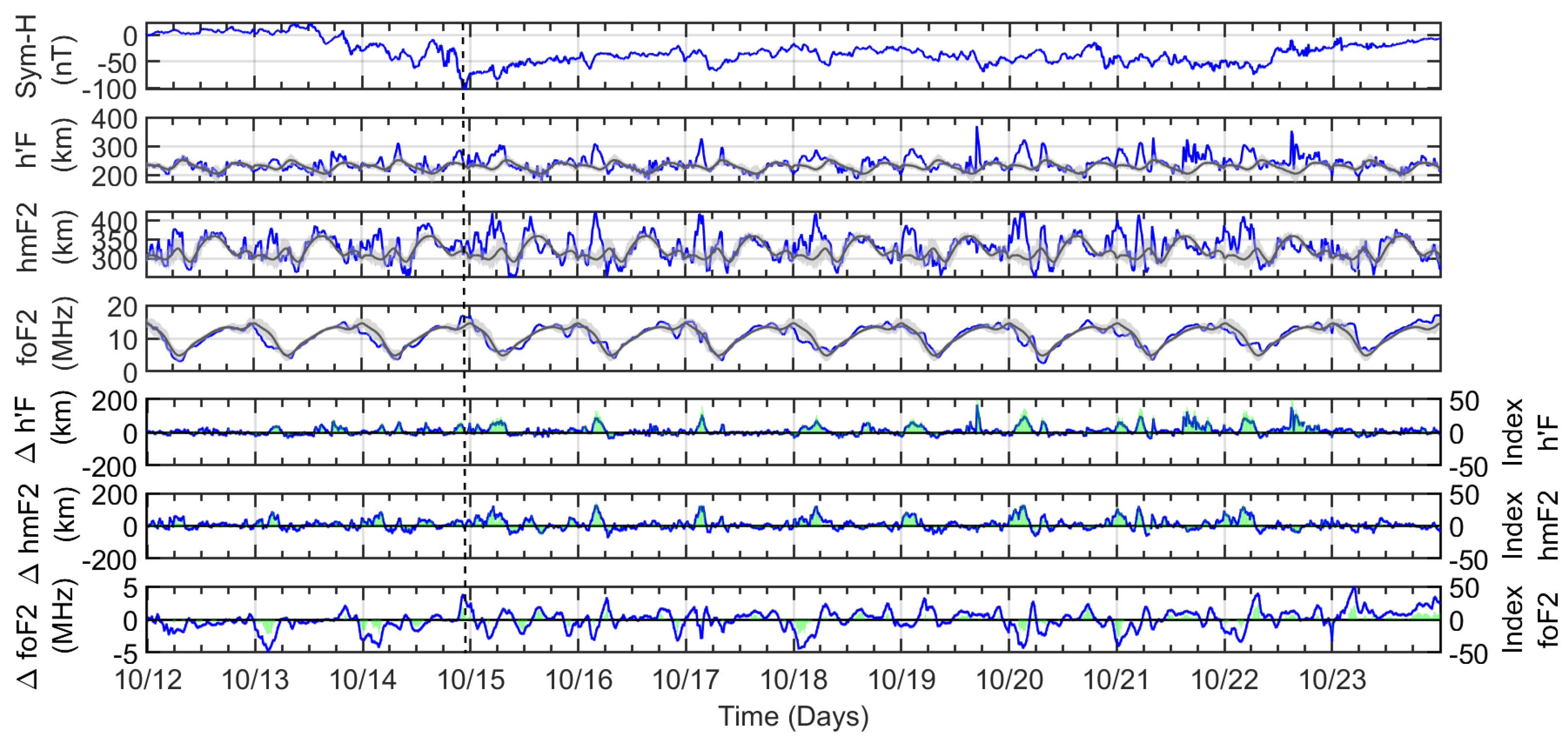
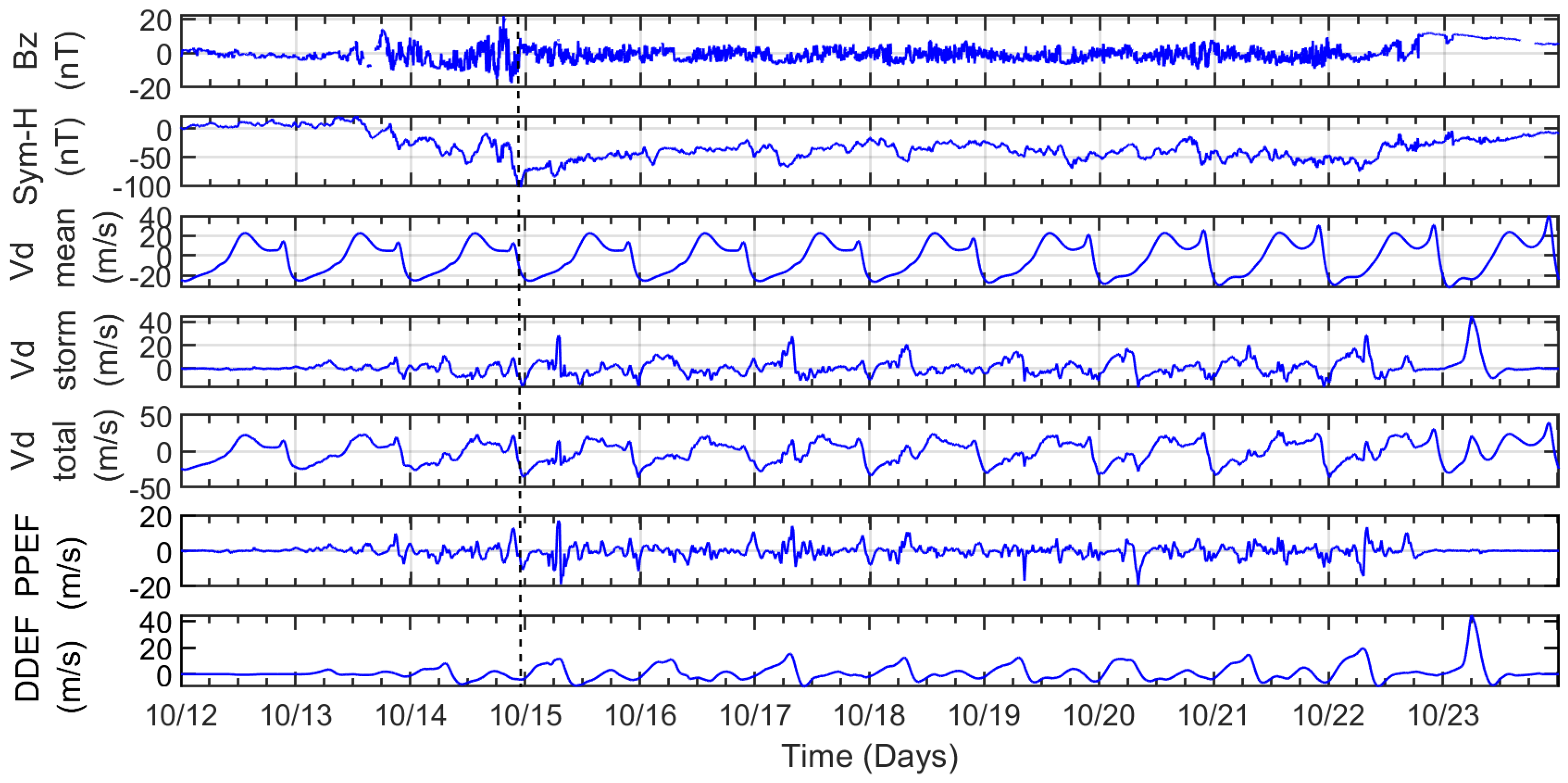
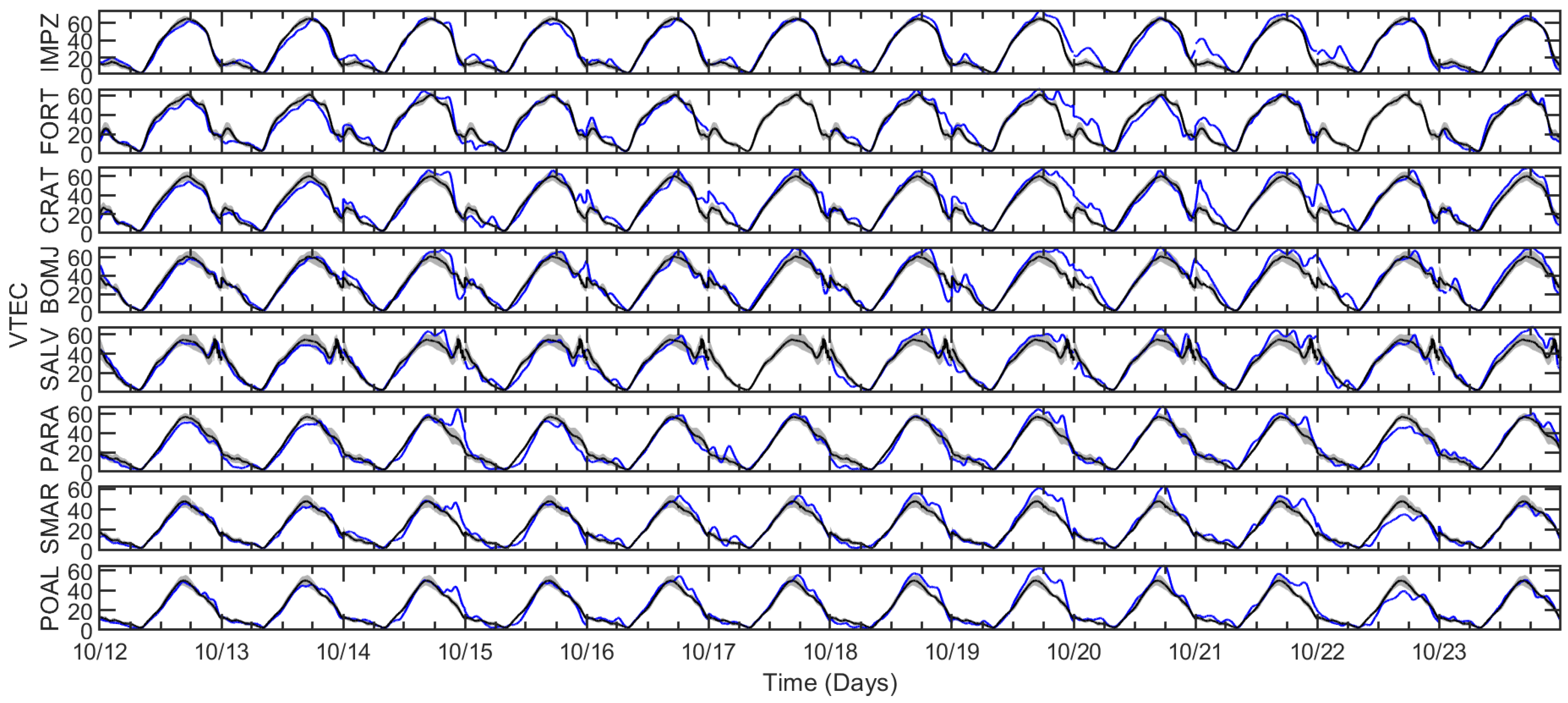
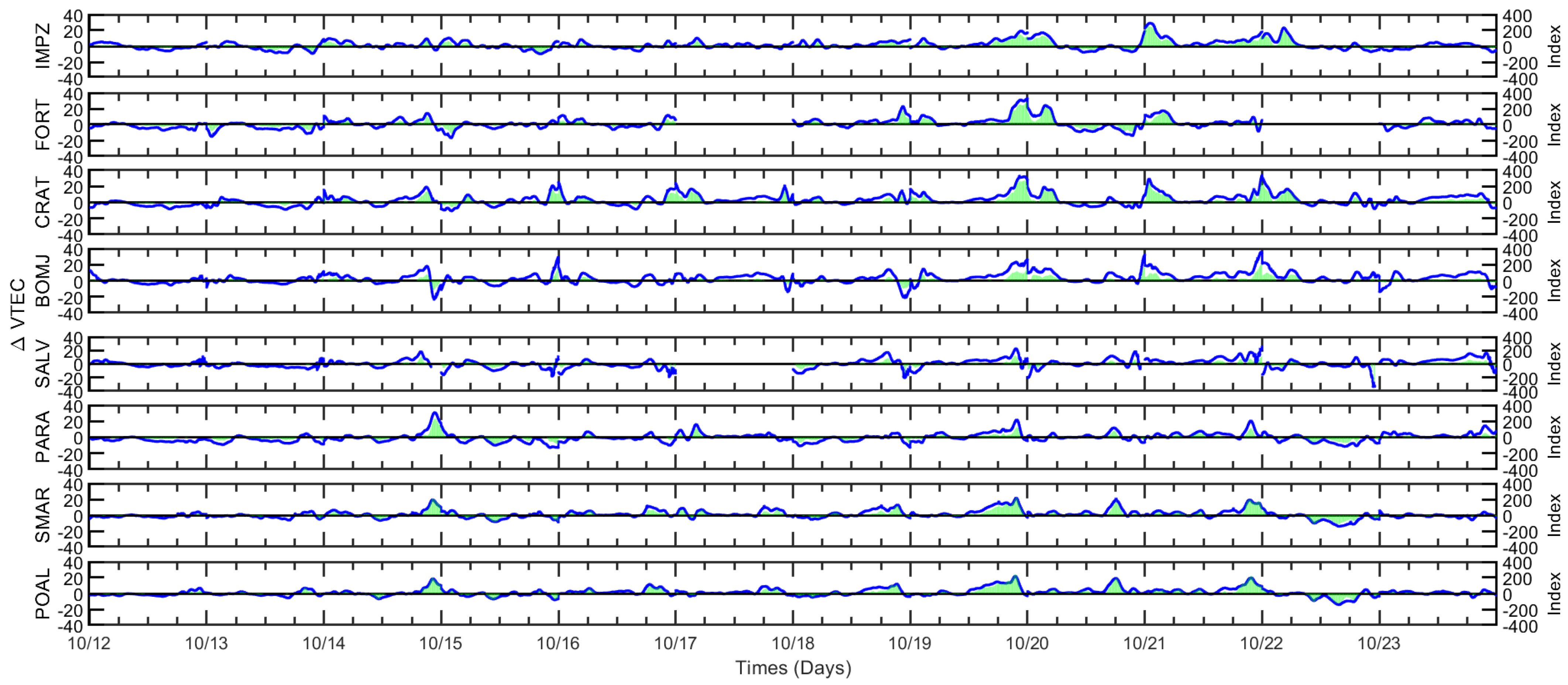
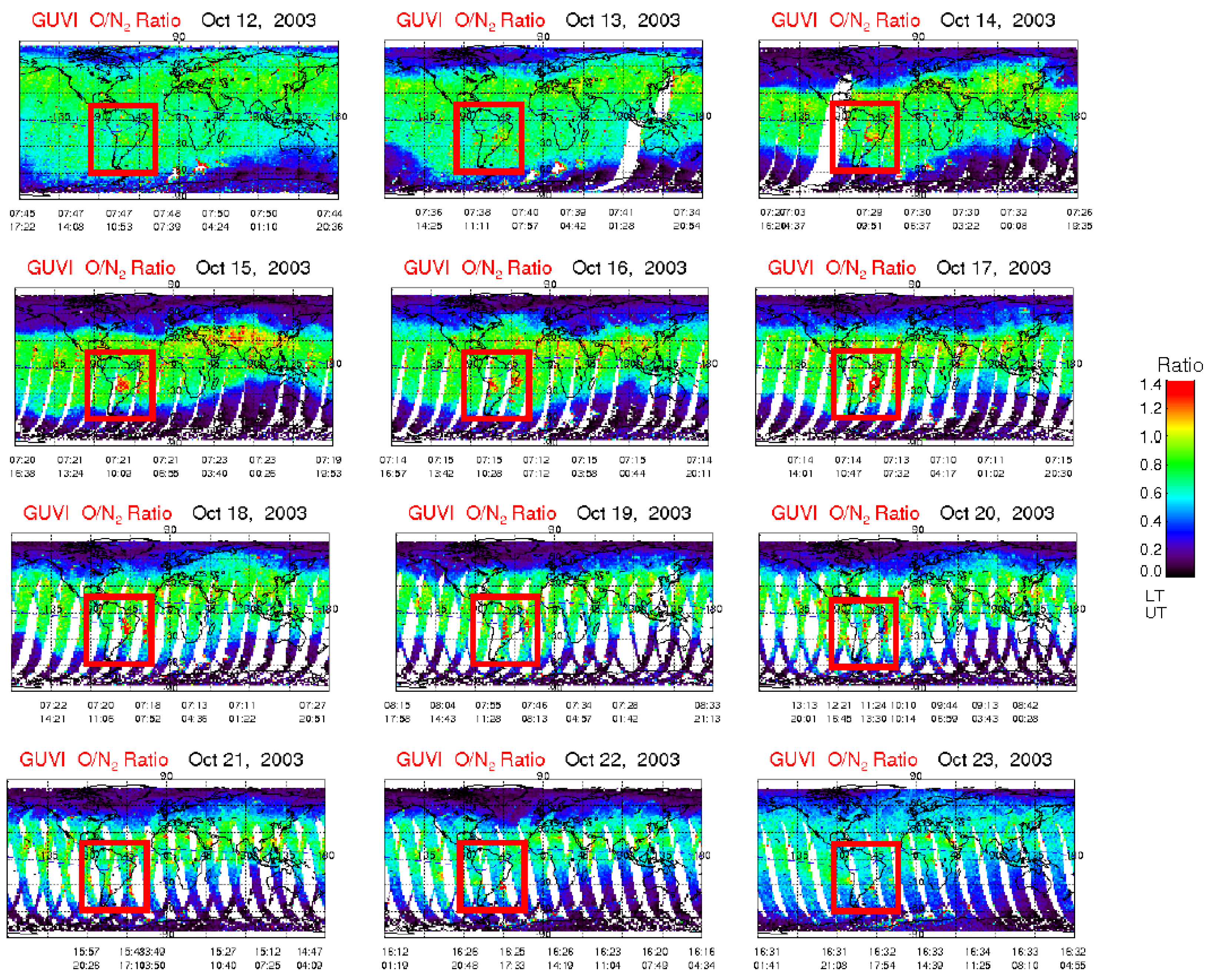
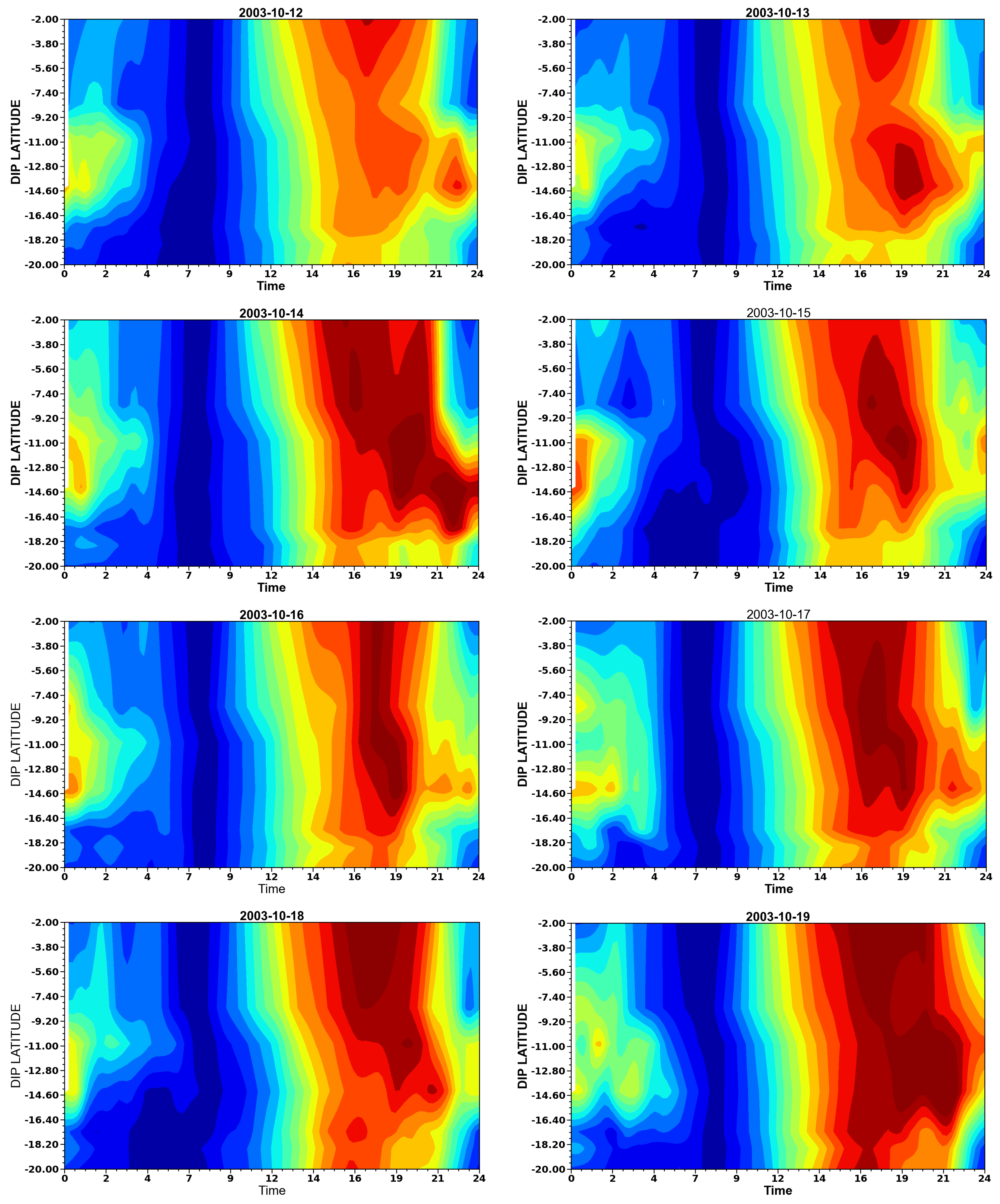
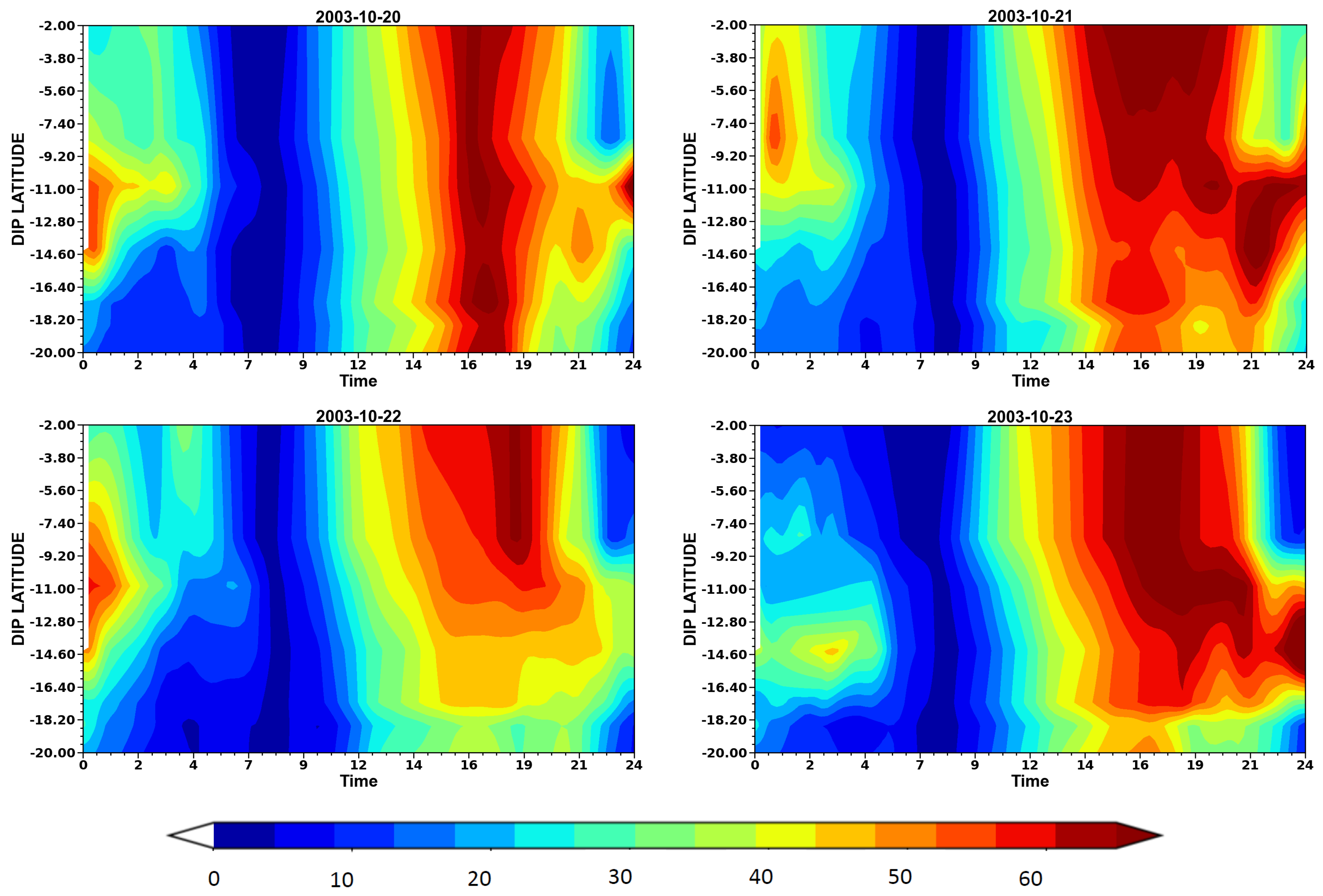
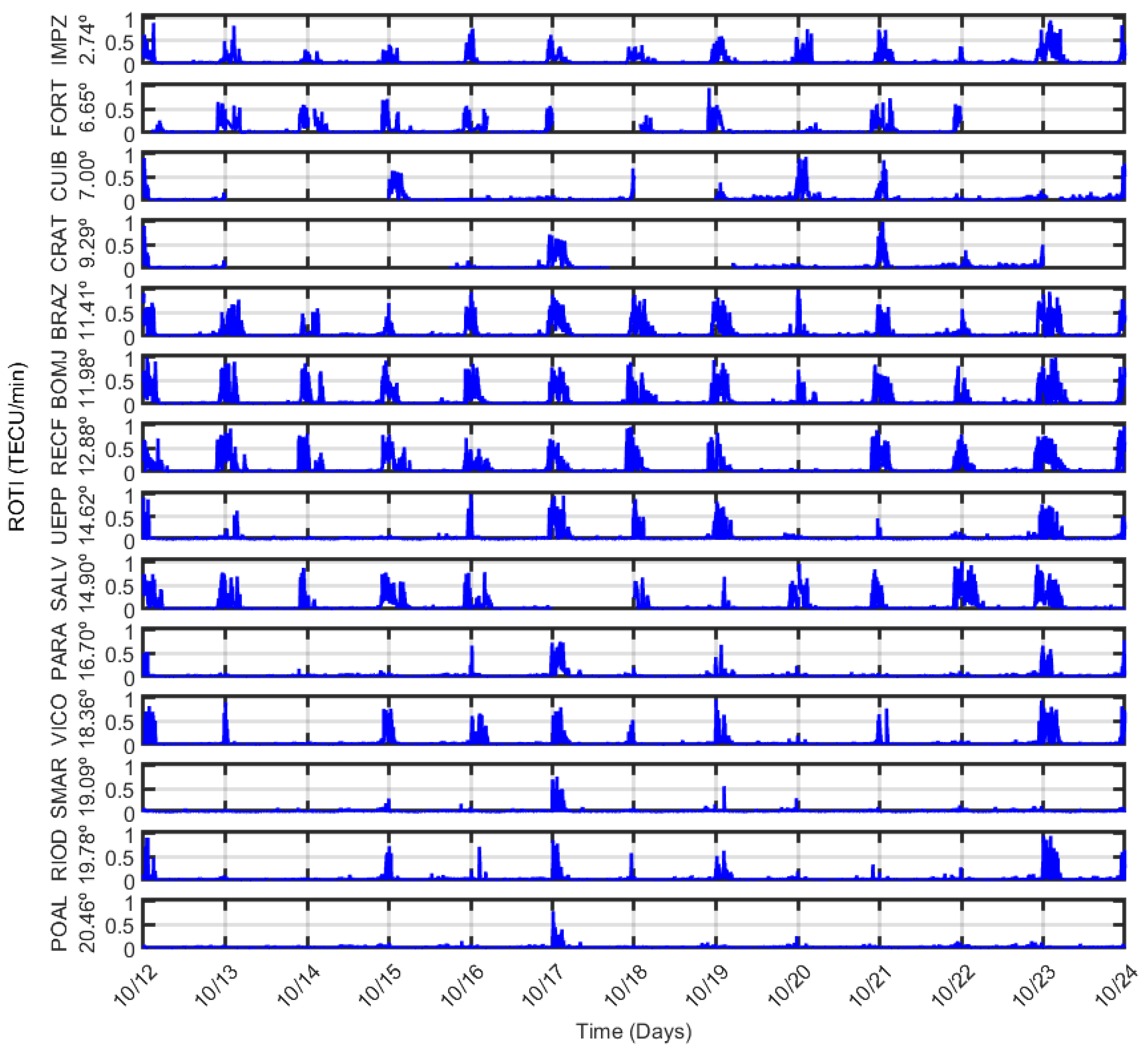
| Obs. Method | Location | Code | Geographic Latitude | Geographic Longitude | Geomagnetic Inclination | Dip Latitude |
|---|---|---|---|---|---|---|
| DIGISONDE | São Luís | SAA0K | 2.53° S | 44.30° W | 3.94° S | 1.97° S |
| Cachoeira Paulista | CAJ2M | 22.66° S | 45.01° W | 33.81° S | 18.51° S | |
| GPS | Imperatriz | IMPZ | 5.52° S | 47.48° W | 5.47° S | 2.74° S |
| Fortaleza | FORT | 3.73° S | 38.53° W | 3.34° S | 6.65° S | |
| Cuiabá | CUIB | 15.60° S | 56.09° W | 13.79° S | 7.00° S | |
| Crato | CRAT | 7.23° S | 39.41° W | 18.12° S | 9.29° S | |
| Brasília | BRAZ | 15.80° S | 47.89° W | 21.98° S | 11.41° S | |
| Bom Jesus da Lapa | BOMJ | 13.25° S | 43.42° W | 22.99° S | 11.98° S | |
| Recife | RECF | 8.05° S | 34.93° W | 24.58° S | 12.88° S | |
| Presidente Prudente | UEPP | 22.12° S | 51.39° W | 27.55° S | 14.62° S | |
| Salvador | SALV | 12.98° S | 38.50° W | 28.02° S | 14.90° S | |
| Paraná | PARA | 25.25° S | 52.02° W | 30.97° S | 16.70° S | |
| Viçosa | VICO | 20.76° S | 42.88° W | 33.57° S | 18.36° S | |
| Santa Maria | SMAR | 29.69° S | 53.79° W | 34.69° S | 19.09° S | |
| Rio de Janeiro | RIOD | 22.91° S | 43.17° W | 35.73° S | 19.78° S | |
| Porto Alegre | POAL | 30.04° S | 51.21° W | 36.73° S | 20.46° S |
Disclaimer/Publisher’s Note: The statements, opinions and data contained in all publications are solely those of the individual author(s) and contributor(s) and not of MDPI and/or the editor(s). MDPI and/or the editor(s) disclaim responsibility for any injury to people or property resulting from any ideas, methods, instructions or products referred to in the content. |
© 2025 by the authors. Licensee MDPI, Basel, Switzerland. This article is an open access article distributed under the terms and conditions of the Creative Commons Attribution (CC BY) license (https://creativecommons.org/licenses/by/4.0/).
Share and Cite
Abaidoo, S.; Klausner, V.; Candido, C.M.N.; Pillat, V.G.; Pires de Moraes Santos Ribeiro Godoy, S.; Becker-Guedes, F.; Toledo, J.A.d.E.S.; Trigo, L.L. CIR-Driven Geomagnetic Storm and High-Intensity Long-Duration Continuous AE Activity (HILDCAA) Event: Effects on Brazilian Equatorial and Low-Latitude Ionosphere—Observations and Modeling. Atmosphere 2025, 16, 499. https://doi.org/10.3390/atmos16050499
Abaidoo S, Klausner V, Candido CMN, Pillat VG, Pires de Moraes Santos Ribeiro Godoy S, Becker-Guedes F, Toledo JAdES, Trigo LL. CIR-Driven Geomagnetic Storm and High-Intensity Long-Duration Continuous AE Activity (HILDCAA) Event: Effects on Brazilian Equatorial and Low-Latitude Ionosphere—Observations and Modeling. Atmosphere. 2025; 16(5):499. https://doi.org/10.3390/atmos16050499
Chicago/Turabian StyleAbaidoo, Samuel, Virginia Klausner, Claudia Maria Nicoli Candido, Valdir Gil Pillat, Stella Pires de Moraes Santos Ribeiro Godoy, Fabio Becker-Guedes, Josiely Aparecida do Espírito Santo Toledo, and Laura Luiz Trigo. 2025. "CIR-Driven Geomagnetic Storm and High-Intensity Long-Duration Continuous AE Activity (HILDCAA) Event: Effects on Brazilian Equatorial and Low-Latitude Ionosphere—Observations and Modeling" Atmosphere 16, no. 5: 499. https://doi.org/10.3390/atmos16050499
APA StyleAbaidoo, S., Klausner, V., Candido, C. M. N., Pillat, V. G., Pires de Moraes Santos Ribeiro Godoy, S., Becker-Guedes, F., Toledo, J. A. d. E. S., & Trigo, L. L. (2025). CIR-Driven Geomagnetic Storm and High-Intensity Long-Duration Continuous AE Activity (HILDCAA) Event: Effects on Brazilian Equatorial and Low-Latitude Ionosphere—Observations and Modeling. Atmosphere, 16(5), 499. https://doi.org/10.3390/atmos16050499








